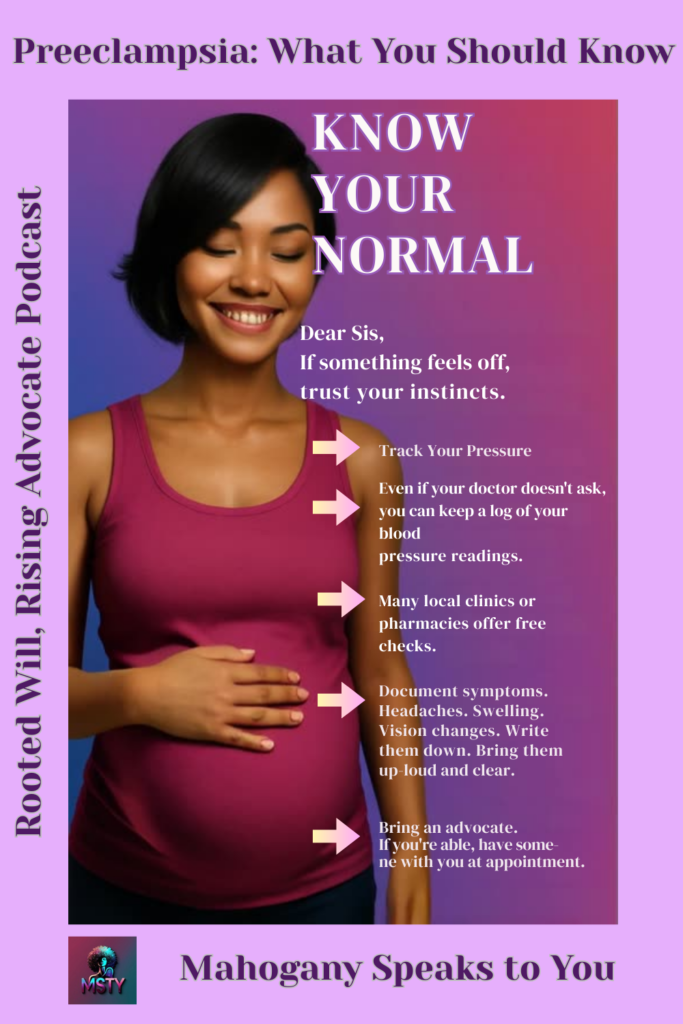
Preeclampsia is a serious pregnancy complication that often shows up after 20 weeks. Do you know how to detect preeclampsia? Picture this: It’s marked by high blood pressure and signs of damage to other organs, most often the liver or kidneys. But what makes it dangerous isn’t just what it does.
- It’s how quietly it arrives.
- Headaches.
- Swelling.
- A shift in your baby’s movement.
They seem like normal pregnancy symptoms, until they’re not. And for Black women, this silence is even more dangerous. We are 60% more likely to develop preeclampsia and 5 times more likely to die from it. Not because our bodies are broken, but because our voices are often dismissed. This article and the podcast episode, Preeclampsia: Early Detection and Advocacy Tools, offer tools to change that by enabling you to better learn how to detect preeclampsia.
Listen to the Podcast Episode on Rooted Will, Rising Advocate Podcast, Preeclampsia: Early Detection and Advocacy Tools
Know Your Normal—So You Can Name What’s Not
Every woman’s pregnancy experience is different. That’s why the first step in protecting yourself is getting familiar with your own normal.
- Are your headaches frequent or brand new?
- Do your ankles usually swell?
- Is your vision changing?
If something doesn’t feel right, trust yourself. You know your body better than anyone. If a symptom feels sudden or strange, write it down. Say it out loud. Don’t wait.
Track Your Blood Pressure Like Your Life Depends On It
Because sometimes? It does. High blood pressure is the biggest red flag and just the beginning in helping you detect preeclampsia. But you don’t have to wait for a doctor’s appointment to track it.

3 Ways to Monitor Your Blood Pressure at Home:
- Use an at-home cuff (many Medicaid programs cover them!)
- Visit your local pharmacy for free readings
- Download a BP tracking app or use a paper log
If your top number (systolic) is 140+, or your bottom number (diastolic) is 90+, especially after 20 weeks, bring it to your provider’s attention. One high reading may be brushed off. But several? That’s data. That’s power.
Document All Symptoms—Even the “Small” Ones
Preeclampsia doesn’t always shout. Sometimes it whispers, and you have have to empower yourself to detect preeclampsia symptoms.
Write down:
- Headaches that won’t go away
- Swelling in your hands, face, or feet
- Blurred or flashing vision
- Pain in your upper right belly
- Feeling short of breath
- Low urine output
- Reduced fetal movement
If your baby isn’t moving as much, or something just feels off, don’t second-guess it.
Keep a symptom tracker handy. Show it at appointments. Ask your provider to take your notes seriously.
Bring an Advocate to Speak with You or for You
Having a second voice in the room can save your life. Advocates are a fantastic asset. This statement is particularly true when you are vulnerable. Who can be an advocate? A partner, best friend, doula, or mother can be an advocate. Bring someone who can:
- Ask follow-up questions
- Push back if something is dismissed
- Support your requests for tests, referrals, or second opinions
It shouldn’t have to be this way. Fixing the system is an ongoing work in progress. We have to be vigilant about ways to protect ourselves within it.
Ask About Labs, Monitoring & Coverage
Don’t leave your care to chance. Ask your provider directly:
- “Can we check for protein in my urine today?”
- “Would it make sense to run blood tests for liver or kidney function?”
- “Do you offer home monitoring programs for patients at risk of preeclampsia?”
Many of these programs—including BP cuffs, urine test strips, and symptom logs, are covered by Medicaid or insurance. You just have to ask.
If Your Doctor Says ‘Admit’—Here’s Why
You may be admitted to the hospital if you show signs of:
- Sustained high blood pressure
- Abnormal labs (liver enzymes, platelets)
- Decreased fetal movement
- Severe swelling or pain
- Danger signs of organ damage
This isn’t punishment—it’s protection. In some cases, you may receive:
- Blood pressure meds
- Magnesium sulfate to prevent seizures
- Steroids to prepare your baby’s lungs
- Induction or C-section if delivery becomes the safest option
You Deserve to Be Heard. You Deserve to Be Safe.
You are not overreacting.
You are not being dramatic.
You are protecting your life—and your baby’s.
When you know what to look for and how to speak up, you turn vulnerability into strength. You are not powerless in this system. You are a warrior. You are worthy. And you are already advocating.
Your Next Steps
- 🖊️ Download the Preeclampsia Symptom Tracker
- 🎧 Listen to the full podcast episode: Preeclampsia: Early Detection and Advocacy Tools
- ✊🏾 Explore more tools at MahoganySpeaksToYou.com
More from The Rooted Will, Rising Advocate Podcast
More from Mahogany Speaks to You

Understanding Anxiety during Pregnancy: What You Should Know

Depression during Pregnancy: What You Should Know
